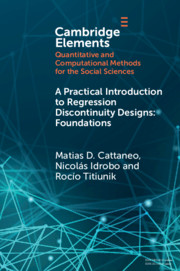Element contents
A Practical Introduction to Regression Discontinuity Designs
Published online by Cambridge University Press: 16 November 2019
Summary
Keywords
- Type
- Element
- Information
- Online ISBN: 9781108684606Publisher: Cambridge University PressPrint publication: 13 February 2020
References
- 270
- Cited by

